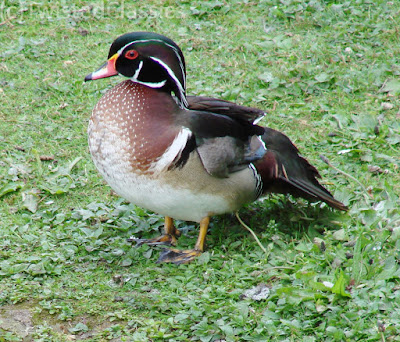The ducklings look so cute when they are this tiny. I think it is the first time I have seen Pochard ducklings rather than the more usual Mallards.
A grey heron was standing on the bank very close to mother and babies - obviously trying to work out how easy it would be to catch some lunch. Fortunately, it was disturbed by all the people looking at the ducklings at the water's edge and it flew off to go hunting somewhere else.
On the narrow lake at the other side of the bridge, there was a mother Coot with at least six little Cootlings.
Another female Coot was sitting on her nest and there were several little babies standing around near her. Her partner got annoyed with another bird and chased it off in a very threatening manner.
A couple of juvenile Egyptian goslings were practising their synchronised swimming a little further along the lake. I thought they were doing quite well.
When I sat on one on the benches to eat my sandwich, I was joined by this grey squirrel. It thought I was going to share, but it was wrong!
It did pose in a very obliging way for some photographs and was probably quite cross that it did not get rewarded for it's trouble - but that's life!
After lunch I came across some grey herons by the lake. This one is in kneeling position - maybe doing yoga?
I like this one's long black feather headdress.
It's the first time I have seen one lying down. I think this is a juvenile.
A mute swan couple were gliding around the lake. There was plenty of pretty cow parsley on the bank.
The couple stopped for a while to investigate the overhanging willow branches, which is where they ate some leaves.
A Great Crested Grebe was fishing in the vicinity. Here it has caught something, maybe a small fish.
The grebe kept disappearing from sight as it dived under the water looking for food. At odd moments it was above the surface.
This photograph shows the grebe going into action as it leaps out of the water before going diving.
There were more Cootlings on the main lake. These poor little Coot babies do look very ugly.
A parent was kept busy with feeding duties.
A couple of parent Egyptian geese were keeping a look out on their sole baby gosling as it swam around in the lake.
I think this Egyptian goose with the light-coloured head is the mother.
The baby eventually got out of the water and was wandering around on the bank.
At the other side of the lake, a white wisteria was looking amazing as it dangled from a pergola.
As you can see, it was located very near a bridge that crosses over the water.
I had now reached another larger bridge that spans the main lake and the area reserved for the park's special waterfowl collection. Photographs have to be taken while standing on the bridge and looking down at the birds. Here there are a pair of male and female Northern Shovelers.
On the bank, admiring the cow parsley, were a pair of male and female Northern Pintails.
On the opposite bank were a pair of American Wood ducks. The drake is standing on the grass. His leucistic partner is in the water and is light-coloured.
Leucism is an abnormal plumage condition caused by a genetic mutation that prevents pigment, particulary melanin, from being properly deposited on a bird's feathers. As a result, the birds do not have the normal classic plumage colours listed in the field guides, but instead can be white or light-coloured like this female Wood duck.
The drake is standing proudly on the bank and showing off his amazing feathers.
There were a couple of Ruddy Shelducks swimming around in the lake.
The roses opposite the cafe in Regent's Park Inner Circle were just beginning to flower. Here are some striking blooms in shades of orange.
Next to them was a bush covered with clashing bright cerise blooms.































No comments:
Post a Comment